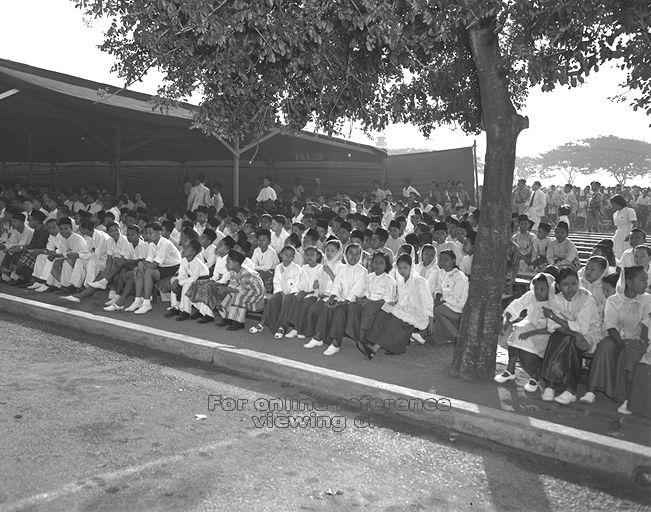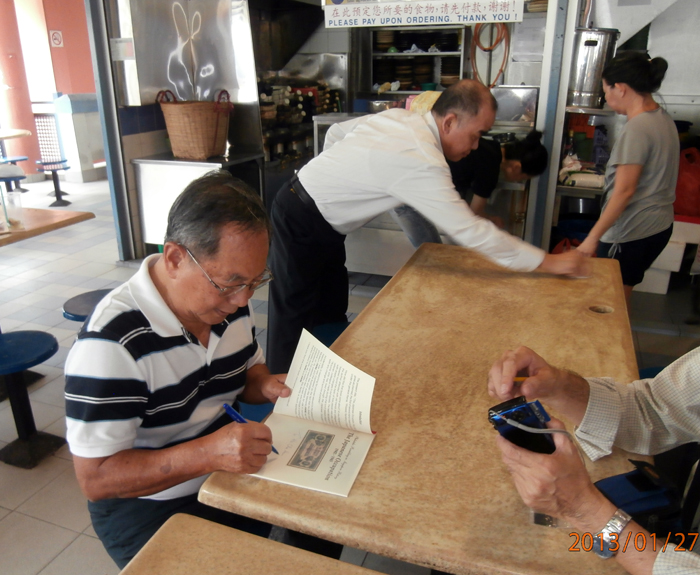City of Singapore
When was Singapore a City before it became a country, our Republic of Singapore?
The population of Singapore in 1961 was 95425 based on 'The Population of Singapore" by Mr Saw Swee Hock (Third Edition) and published by the Institute of Southeast Asian Studies, 1 Jun, 2012.
As a British colony, Singapore was conferred city status by a royal charter from King George VI in 1951, when Singapore was then a crown colony of Great Britain. The original Municipal Council was therefore renamed City Council, and the Municipal Building was renamed City Hall.
The City Council of the City of Singapore and the Singapore Rural Board were abolished in 1965.
While the Union Flag flies over the Municipal Building and with Singapore's 50,000 future citizens watching, Governor Sir Franklin Gimson handed to F P F McNiece, President of the Municipality, a shallow red box containing the Royal Charter and Seal thus declaring the Town of Singapore as a City.
This day is known as "CITY DAY"
Transcription/text of Royal City Day Charter by King George VI of Great Britain
George the Sixth, by the Grace of God, of Great Britain, Ireland and the British Dominions beyond the seas, King, Defender of the Faith; to all to whom these Presents shall come, Greetings.
Whereas the inhabitants of the Town of Singapore in Our Colony of Singapore are a body corporate by the name and style of the Municipal Commissioners of Singapore; and Whereas We, for divers good causes and considerations Us thereunto moving, are graciously pleased to raise the said Town to the rank of a City.
Now, therefore, know ye that We of Our especial grace and favour and mere motion do by this, Our Royal Charter will, ordain, constitute, declare and appoint that Our said Town shall on the twenty-second day of September in the year of Our Lord one thousand nine hundred and fifty-one and forever thereafter be a City, and shall be called and styled THE CITY OF SINGAPORE, instead of the Town of Singapore, and shall thenceforth have all such rank, liberties, privileges and immunities as are incident to a City.
And we do further declare and direct that the Municipal Commissioners of Singapore shall thenceforth be one body corporate by the name and style of THE CITY COUNCIL OF SINGAPORE, with all such powers and privileges as thet would have had as the Municipal Commissioners of Singapore and as if they had been incorporated by the name of the City Council of Singapore.
And further know ye that We, trusting in the discretion, fidelity and care of Our trusty and well beloved Sir Franklin Charles Gimson, Knight Commander of Our Most Distinguished Order of Saint Michael and saint George, Governor and Commander-in-Chief of Our Colony of Singapore, do give and grant by the tenor of these Presents unto the said Sir Franklin Charles Gimson full power in Our name to declare and make known Our Pleasure herein.
In Witness whereof We have caused these Our letters to be made Patent Witness Ourself at Westminster, the twenty-forth day of July in the fifteenth year of Our Reign.
By warrant under the King's Sign Manual
City Day, 22 September 1951, the Town of Singapore was officially made a City of the British Commonwealth, by an official proclamation of a Royal Charter by King George VI. Singapore City Day festivities began with an official parade, in the presence of 50,000 of her citizens at the Padang.
On the Grandstand Sir Franklin Gimson sat between Malcom MacDonald and T. P. F. McNiece, Sir Charles Murray-Aynsley and Sir Henry Gurney sat on the side of them. Behind in a semi-circle row were the Municipal Commisioners, and behind them the heads of Municipal departments. In the guests' enclosure sat Service Chiefs and dignitaries. The reserved enclosure had notables of Singapore, officials and executives and their wives, leaders of all the city's communities. Children's Day uniformed youngsters were in the front seats and other places of honour to witness the simple but solemn ceremony.
The historic ceremony began when the Governor read a message from the ailing King George VI, which included his "best wishes to the City Council...and to the citizens of Singapore on this notable occasion". This was followed by Sir Franklin's speech on Singapore's historic past, and its aspirations of the future, to which he ended with "I am sure we can all invoke with virile and active confidence in the future, its proud motto, all the prouder today, "Majulah Singapura"' (meaning 'Let Singapore Flourish!')".
Then the archaic wording of the Royal Charter from His Majesty the King, was read to the people by the Chief Justice Sir Charles Murray-Aynsley. Then an A.D.C. handed the Charter to the Governor Sir Franklin Gimson, who said, "On behalf of the King I present to you the Royal Charter and Seal, conferring City Status on the Town of Singapore" and then presented a shallow red box which contained the Royal Charter and Seal, to the President of the Municipality, T. P. F. McNiece. From that moment the call of trumpets heralded the proclamation as McNiece, dressed in his Malayan Civil Service uniform, became Lord President of the City Council, and the Municipal Commissioners of Singapore became the City Council of Singapore.
Festive attractions
 |
| The spectators watching at the floats from the Sir Stamford Raffles statue at Victoria Memorial Hall |
The event at the flag-bedecked Padang, had all the trimmings of pomp, pageantry and Royal splendour. The city was dressed for the occasion, especially for the night with thousands of light bulbs stringing buildings and illuminating structures.
Many activities were lined up to take place around the island "on the hour" throughout the day. Big attractions were lined up for the evening.
The city was in traffic chaos and jammed everywhere. Thousands of men, women and children in a festive mood, jammed and crammed the streets or seafronts to catch the best angle and action of the three big shows, the Sea Dragon, the fireworks display, and the City Day Procession. At least 1,500 policemen were assigned to control the overwhelming numbers.
The Chinese community ended the day's celebrations with their three mile Chingay-like City Day Procession surpassing any within living memory. Sponsored by the Chinese Chamber of Commerce, 10,000 Chinese men, women and children from more than 230 trades, guilds, associations, societies, clubs, schools, presented a five hour show that hundreds of thousand spectators will never forget. Crowds, masses swarmed around Collyer Quay to catch the parade as well as the Sea Dragon.
The night parade of about 300 floats, decorated lorries and buses were assembled all the way up to Keppel Harbour in readiness for the start. After a 15 minute delay caused by traffic jams, the procession kicked off at 7.45 pm, at the starting point on Raffles Quay. A dozen colourfully dressed Chinese maidens carrying lanterns led the procession through thick and uncontrollable crowds along the route. When the procession reached the statue of Sir Stamford Raffles, thundering explosions of Chinese crackers ignited by candles, launched the 60 ft long Dragon Dance. With eyes spouting flames, the flowing luminous body danced and pranced to the beat of Chinese drums, gongs and cymbals, before the statue.
Victoria Memorial Hall was the designated performing platform or staging area for the acts. Commercial organizations and other communities like the Malays and Indians also participated with illuminated and decorated floats that played taped music or had live-band music! The Land Dragon procession took top prize for the Best Exhibit, the Lion with the Royal Crown built by the Teochew Huay Kuan (clan association) of Singapore, was awarded second prize, and third prize to the Model of the Town Hall.
City Day brought together 300,000 people or more, the largest crowd the city had ever seen, and for an event they will long remember.
Author
Vernon Cornelius-Takahama, 2000 (Source: Singapore Infopedia, An electronic encyclopedia on Singapore's history, culture, people and events).
City Day Celebration at Municipal Building on 22 September, 1951
 | ||
| Inspection by the Guard of Honour |
Presentation of "City of Singapore Certificates"
How different are the presentation of the Singapore Citizenship Ceremony today?
Singapore started to hold its first National Citizenship ceremony on Aug 18, 2007 to reinforce the significance of citizenship and to drive home the message that both indigenous and new citizens share a common identity and destiny.
 |
| Photo courtesy of Bukit Batok East blog |
Labels: City of Singapore










































































































